#insight: alvin
Explore tagged Tumblr posts
Note
anything you're hoping to see in chapter 5 maybe?
toriel snap. carol and kris' rapport. asgore becoming interesting. dark world rudy. more dessknight and insight into what the fuck happened to her. any new gaster dialogue whatsoever, i miss him. susie susie susie susie susie anything and everything susie. alvin's perspective on *gestures vaguely* everything going on. a dark fountain of the entire town during the festival. new hometown area when the police tape gets removed!!! roaring ending.
#sans (...?)#idk I'm scared of getting more deltarune sans content#answered asks#deltarune#dr spoilers
179 notes
·
View notes
Note
What role do you think Alvin will have in chapter 4? Since it will be a church dark world.
I do honestly have a lot of big thoughts at least in what Alvin's relationship is to the Knight, expressed some with this post and mostly with this comic!
But as for chapter four specifically, I'm mostly hoping that we get some more insight into his relationship with Gerson and the rest of his family, some more history from him on what happened with the Dreemurrs and Holidays in the past, and hopefully some good examples of what actually is entailed with the monster's religion and the Angel. I don't think he's really going to take on an antagonist role per se, at least not deliberately, and I honestly don't think we'll actually see him in the Dark World. (Noelle, Catti and Jockington will be making an appearance tho, I think!)
I do however, have this image in my head of everyone being in church for service, Alvin asking the congregation to close their eyes in prayer, and while everyone's eyes are closed, we see the darkness smoke start to fill the area. I think that'd be a cool and creepy transition into chapter four's Dark World!
34 notes
·
View notes
Text
okay. because deltarune is less than a week away and i never managed to find time and/or a will to make a full video on it - i'll be writing down every single chapter 4 prediction i have. i'm omitting chapter 3 because we know significantly more what we can expect so it's less fun to speculate. also ever since church dark world has been confirmed and killed any holiday manor heathen in sight my ego has been inflated to infinite proportions so i'm confident that at least 50% of my predictions will be correct. also also this is a very long and extensive list so. keep that in mind
it's going to begin right after chapter 3's ending - which i believe will be sealing the fountain - after which everyone "wakes up". because of that toriel will be more easily convinced that what she experienced was a wild dream
we will not be able to take everything with us - chairiel for example, will stay at dreemurr's. i've seen many people worry about tenna's inclusion because of that, but i don't think it's going to be that complicated. personally, i don't believe tenna is literally the tv - they're the antenna that broadcasts whatever is on the screen. while toriel would undoubtedly raise eyebrows at smuggling the tv, she would be less concerned about missing the antenna since the tv hasn't been used since the divorce anyway. but in the case tenna IS the tv, i won't be surprised if all the "kill your tv" stuff gets fulfilled
toriel will drag us to the church. my personal headcanon has always been that even after the divorce toriel and kris (and asriel?) still regularly visited the church as a family tradition, given that they're a VERY religious family. toriel and kris going together is probably a routine for them at this point - which explains perfectly why kris AND susie would end up there. susie will probably tag along because she has nothing better to do than to come back to her likely miserable home life (which i'm sure we'll get insight into in ch3, but i digress). before we get ready for the church though...
we'll have the first light world exploration segment. yes, first. the reason i believe so is because even back in 2022 status update, we've been given two different screenshots that clearly show us different points in time. it will start raining in the second segment (i'll elaborate why i think it's raining in the second one later)

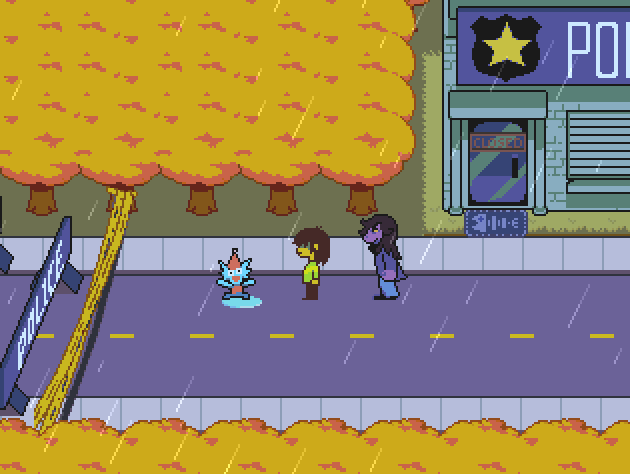
i'm not sure if the fabled "light world save points" will be present in the first segment, unless we get a very unusual sequence break. we'll be free to explore the town and visit the closet as seen in the screenshot below (note the shadowguy!). because we'll have access to the closet at any time in this section, a save point in the light world doesn't seem to be needed. but who knows
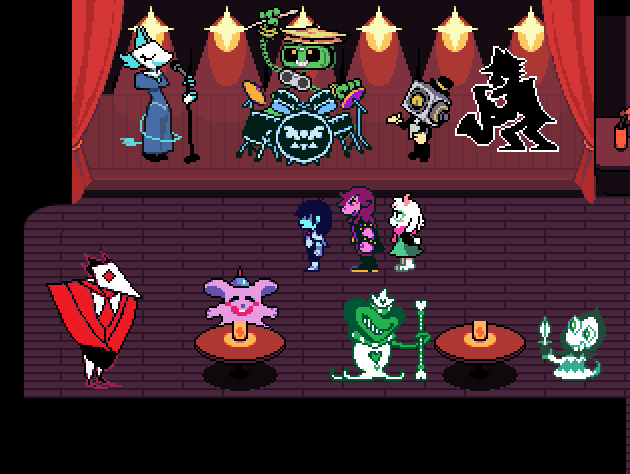
i believe the "point of transition" to end off light world exploration will be the diner scene. very likely a long cutscene with a lot of insight about susie's home life and her feelings about... everything else, really
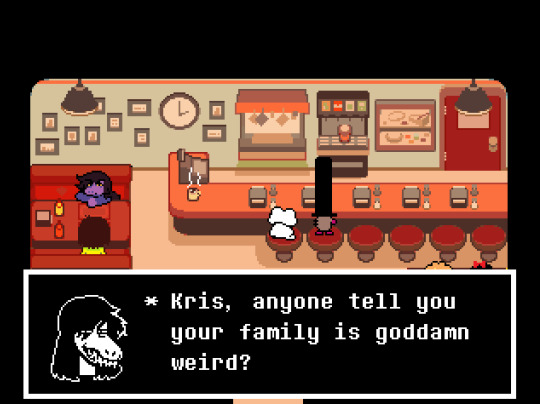
after the diner it's time to finally go to the church. now, i don't think the whole church will be covered in darkness, despite the double doors theory. everything will seem normal and play out normal
time for the first extremely specific, fanficesque prediction of the night: we'll sleep through the entire liturgy. as much as i would love getting spoonfed every single piece of information there is about the angel, the delta rune and more, i don’t think we'll be served it on a silver platter. and replaying deltarune made me remember this wouldn't be the first time a time skip like this happened. i can only imagine that after not sleeping the entire night before and then running around hometown doing fuck all, kris and susie are bound to end up really, REALLY tired. so when they get there they pass out as soon as father alvin utters a single word. it would be a fun cheeky way to conveniently hide crucial exposition from us and make us more engaged in learning by potentially visiting a dark world CENTERED around the church itself
after the liturgy is over i can see a short segment where we can walk around and talk to everyone for some flavor text. i also believe this is where we'll see this specific susie from toby's concept art (she seems to be pouring herself the sick fruit juice). we might also see the "sitting noelle", though that one is so detached from the context it could end up being anything, really (and given the background of noelle's sprite... i think it might show up in an even later section)

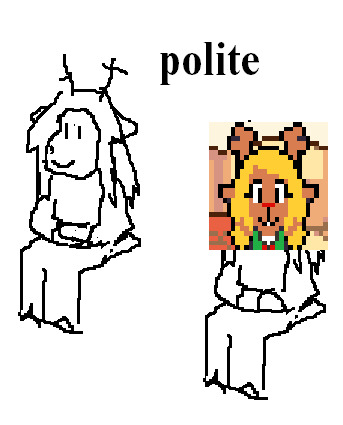
speaking of noelle, we'll definitely have a chance to talk to her. i think realistically we'll learn that rudy didn't end up feeling well enough to attend after all, because i don't actually believe a word he says. rudy is not getting better, he's getting worse. this leaves noelle feeling very down. after the service she'll probably go visit him right away... but not before inviting kris and susie over to her house for a sleepover. even more likely given that, from toriel's perspective at least, there has been a break-in in the dreemurr house. her invitation could be a generous offer to have a safe place to stay while the police deal with the problem as well as an excuse to invite her crush. we have more important things to attend to for now though. it's time for the youth group meeting. but when we open the backdoor... you probably can guess where this is going
what will be the escapist theme of the dark world? i can see three possibilities, or even a mix of all of them happening:
straight to the point - religion as escapism. finding solace in spiritual beliefs when life gets hard
a literature themed dark world - connections to gerson as a writer and in turn HIS weird connection to dark worlds presented as "dreams". furthermore we've been given translation sneak peeks with deliberate references to classic literature (dante's inferno and hamlet)


3. musical theming - the existence of the choir and general association with music in organized religion
what darkners can we expect? this one is harder to guess, because up until we recently we have gotten no sneak peaks into chapter 4's dark world at all. the only enemy we knew of was cup walka because that little guy never fit into chapter 3's tv theme anyway
the main boss
my answer's going to be boring, because i'm going off of the chess theory, but so far i'm leaning towards the "bishop" as the main antagonist of the chapter. sadly, i have no idea what item they could even correspond to in the light world, it'd be like throwing darts blindfolded. because of that it's also hard to think of any concrete goal or motivation
secret boss
equally hard to crack, but strangely has more to work with. the difference between ch3 and ch4 secret boss predictions is that we are far more familiar with the objects inside the dreemurr household, meanwhile we have no idea what the interior of the church even looks like. but if i were to take a wild guess? i like the idea behind the angel doll made by kris and asriel. we have the themes of being a discarded item (the doll was never finished because kris and azzy kept making the wings too big) and being connected to the church (literal angel doll). we also have compelling parallels for the vessel and the player (with angel!player theory in mind) and a nod to an arts'n'crafts angle of the youth group (something i'll briefly mention with cup walka)
i want to also mention the sky mantle that has existed in the game since chapter 2 demo, but has never been used. the most notable thing about it is that it protects against elec/holy attacks, which correspond to element 1 in the code. said elemental pair has also been alluded to in the spamton sweepstakes qna - where spamton lists it alongside puppet/cat (spamton's element), dark/star (possibly ch3 secret boss?) and death/scythe (likely being jevil's). and though spamton calls it thunder/light instead, it still corresponds to elec/holy - in this case thunder being a synonym for electric and light always being used in religious context (alvin calls upon the angel to "light [kris's] way"). what's interesting is that we already have a mantle item that we know of - the shadow mantle. though that one is also unobtainable (and doesn't even exist in the game files to begin with). we've been told by seam it's the only way we'll be able to defeat chapter 3's secret boss - perhaps we can repurpose the shadow mantle into the sky mantle later? especially given that the two secret bosses might be of opposing elements (dark vs light)
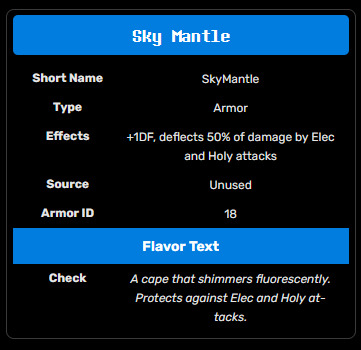
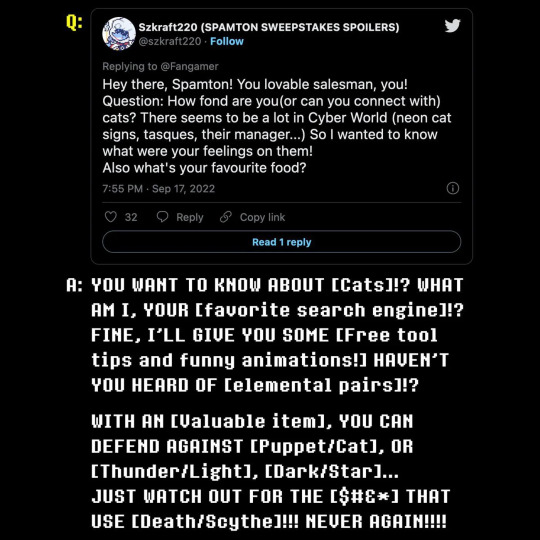
guei
the first enemy we've seen. they seem to be inspired by the chinese spirit of the same name. their entire appearance seems to be based on the symbol as well (connections to a literature theme)

this guy
i have no idea what their role could possibly be. they seem to be waiting by the "jockington grows the beard" for whatever reason (giving guidance to the fun gang?). their light world counterpart seems to be based on hostia shared during the holy communion


cup walka
our favorite little marching soldier. its feather reminds me of hats marching bands wear, which could support a music oriented dark world. as for its light world counterpart - i think it's an arts'n'crafts creation made at a youth group meeting. looking at it closer, everything about its design SCREAMS like something a bored kid made during the youth group session. a red solo cup with googly eyes, popsicle stick legs and a fake feather glued on top. a marching soldier born from the hands of a believer, climbing to the top in endless pursuit of reaching HEAVEN

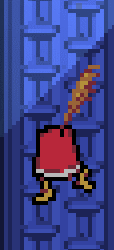
a silly addendum to cup walka - i am convinced this is where we'll see roast chicken from toby's bluesky shitposting. probably as a small chance encounter similar to the annoying dog in giga queen's appearance
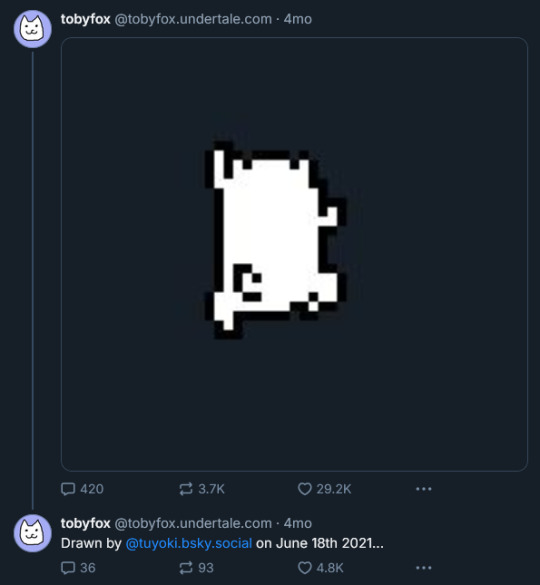

who will join us in the dark world? again, i don't have anything innovative or anything, but;
catti
she has been long set up as an important character. for one - she has an actual talk sprite. but seriously - catti already has a lot of potential as a character not just in her own right, but how she can bounce off of our protagonists. she's very much a baby goth - she finds her cheerful family annoying and, in real teenage angst fashion, feels like she cannot find any common language with them. we know that she's interested in the occult, even sharing her findings with noelle. we also know she studied occult with kris, something they seem to be very interested in as well. there's a theory that makes the connection between a certain poppup interaction, kris's interest in the occult, and us. some theorize catti was involved in whatever ritual brought us to deltarune in the first place - whether it summoned us directly or through someone else. i feel like it's a very interesting concept that could be expanded upon more. the connections to the occult also give room for some fun glimpse into her character, especially when contrasted with a quote unquote holy place. i can imagine her being less than enthusiastic about the youth group meeting only to turn it into a dark fantasy adventure that lets her express herself more freely
another part of her character is her supposed rivalry (or maybe just plain disdain) for susie. it seems bad enough to the point where susie will avoid her at work. and since susie is the actual main character of this story, having her and catti actually confront each other would be perfect for character growth. i can totally see catti relentlessly antagonizing susie the entire time until we get the staple "aren't you wondering what susie is up to?" moment from ralsei where we see them having a little heart to heart. maybe have a conversation about how susie could never fit in anywhere until she started going on these adventures, and catti realizing she's not as bad as she seems. in my eyes they have more in common than they'd think
jockington
being completely honest, i didn't think much of him prior to the trailer and new screenshots. i knew he would be there because he and catti are a package deal, but truthfully i couldn't figure out his role. well...
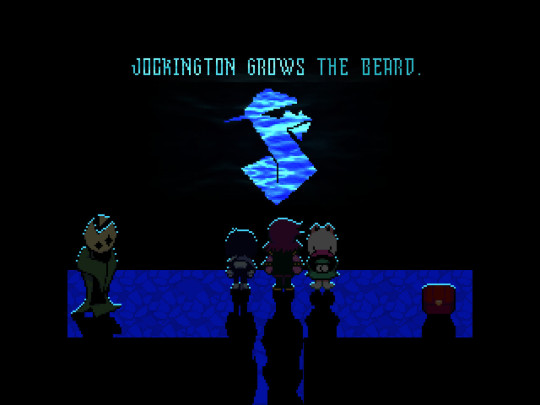
(we'll get to this later)
father alvin
alvin's inclusion is too obvious by this point. his connection to gerson (and by proxy the dark world mystery), knowledge about the angel and the delta rune, as well as the set up in chapter 2 - all make it obvious he'll have a bigger role in the future. and what better chapter to utilize him other than the church?
i am genuinely invested in his character, knight or not, and would love to see him join the adventure as well. as for his role, ideally i'd see a man of faith such as him easily persuaded by the fantastical reality the dark worlds provide. maybe he could be manipulated by the antagonist, whoever it might be. and personally, i'd love to see him challenge our involvement in the story. given that monsters worship the angel and the legend seems to be against it, i can see him making us question whether we're doing the right thing or not. and no matter how he got to that conclusion, he… might be right, for all we know. and i think that would be a perfect foil to ralsei's outlook on the legend. that's right we're getting ralsei and alvin parallels baby. both characters devoted their lives to their faith, and i would love to see ralsei's resolve slowly break as he sees himself reflected in the old man
and all this doesn't even cover alvin's daddy issues and a VERY likely gerson subplot
noelle
although i said before that i can see her leave soon after the service to see rudy, i'm also 100% convinced she'll join us as well. we have to keep in mind she's someone gaster calls "VERY VERY WONDERFUL" (a grace only kris and susie get - even ralsei doesn't get the same treatment). she's a main character, too. her importance will only increase with each chapter. not to mention the weird route follow up
we also have to mention her angel imagery. whether you believe in angel!noelle theory or not, it's there. excluding her from an angel-oriented dark world is pretty much impossible
as for the weird route - i believe that the new spamton sweepstakes gave us a definitive answer. deltarune.com/chapter5 gives us numbers from 1 to 5 - each representing the chapter. if you visit any other chapter site except chapter 4, you are told whether something is "applicable" or not. the applicable in question is the weird route. we know this, because clicking number 2 from /chapter5 redirects us to d.mp3, the track that plays right before we fight berdly in the weird route. the size of the numbers seems to also indicate how impactful/important the weird route will be. 1 is incredibly small, 2 and 3 are equal in size (chapter 3 is seemingly "Not Applicable... But..."), 4 seems smaller... but chapter 5 seems even more significant. but how does any of this make me convinced noelle will be in the dark world? it's because the number is visible. chapter 1 and 3 are the only ones hidden in the darkness, because noelle won't be present there. she seems to be the key to the game-breaking nature of the weird route
(as a side note. i've always joked about holiday manor believers being crazy... but i'm willing to hear them out on chapter 5)

with that aside, let's go back to the actual dark world. again, i cannot feasibly predict the order of events, what we'll see and etc. we'll definitely learn more about the angel and the religion as a whole - potentially making theories like player!angel apparent, or maybe still keeping it ambiguous. either way we'll definitely get some crucial exposition. i've also seen people speculate that we might learn something about the history of monsterkind (maybe humankind too?), which i would really love
another hope of mine is to see the inclusion of the amalgamates. the mention of the objects buried with them seems deliberate, like something being set up. and while the church on the surface isn't connected to the graveyard - well, the items are buried beneath the ground, just like catacombs, aren't they?
i do think we'll get a glimpse of the knight in this chapter (assuming it's not kris - but then again if it's them we'll learn either way). assuming the chess theory is correct they're next in line as a boss, and chapter 4 is a good set up for it
now, what about Jockington Grows The Beard? people have pointed out that the texture on jockington is the same one as the tree from lostwheretheforestwouldgrow - which is also a slightly altered texture from IMAGE_DEPTHS, which in turn is also used for the texture of the fountains... yeah safe to say they're all related. i believe that jockington's beard will lead us to a darker world. the trailer gave us two scenes from chapter 4 in which kris and susie are noticeably off-color. and mind you - they have their regular color palette in the jockington screenshot. given the connections between the dark and the ocean you could easily compare it to how the deeper you go, light doesn't reflect the same, so all the colors become a different hue



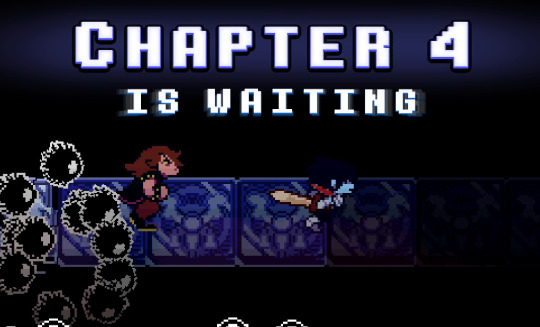

additionally to the darker world - who on earth could've possibly opened a fountain within a dark world? i had two predictions, one probably more likely than the other. the first one - i could totally see alvin opening one out of spite and due to his own faithful delusion. but that wouldn't explain why jockington grows the beard. so the second, far more likely one - is that jockington did it. and that's his big break this chapter. jockington is very obviously perfect. he has no real issues, and everybody loves him. so of course the reason he'll open a dark fountain isn't because he has family struggles like all the main characters - it's because he wants to grow a beard. because he cannot do that as a snake. once he finds out you can make more dark worlds he'll gladly take the opportunity, because unlike berdly in chapter 2 he didn't get a scolding from ralsei. or hell, maybe he won't even care. i can envision the entire scene going like... we defeat the main boss, and as we're off to seal the fountain we realize that jockington isn't with us. and then we hear a deafening roar and a flash of light on the horizon. we'll probably race against time to seal the darker fountain lest the roaring comes prematurely
after everything is done, we close the fountain and once again find ourselves in a normal room. i can see ralsei using pacify on alvin, catti and jockington like (i believe) on noelle and berdly in ch2 - but he might leave noelle be this time. i can see alvin leave in a rush to process, what he thinks were, angelic visions of heaven which would then give us the opportunity to take all the items with us. this is where the second light world segment happens. this time, it's raining. i assume we'll be free to explore the town again, to check up on anything new and bring back all the darkners to the closet again
time for the second extremely specific, fanficesque prediction of the night: we'll visit the apartments. maybe. not only did there exist an unused room corresponding to the apartments in chapter 1 demo (fun fact - just like toriel's room and an area behind the gate to noelle's house!), i also believe susie lives there. i often see people mistakenly call it just snowy's house when the building itself is an apartment complex - i mean i don’t know why, i find it quite simple. and given susie's reaction in chapter 2 i find it very likely she's also a resident. i don't actually believe susie is homeless like a lot of people do. neglected, underfed and without a room of her own, sure, but i don’t think she literally lives on the streets. i could totally see us briefly getting in because susie has to get something from her home for the sleepover or something. i've seen a really cool concept of that by shadowkristal which made me yearn for something like this in game even more. in the case something remotely close to this happens, i can see it being a point of transition like the diner scene, after which we're locked into going to the holiday manor

we arrive at the manor and hang out with noelle, probably discussing what happened during the church. i like to think this is where the making chocolate and gamer moment concept art will appear (and maybe the sitting noelle, given the background of her sprite?). we'll also finally meet the mayor and get a significant lore drop about dess and the circumstances which she disappeared in
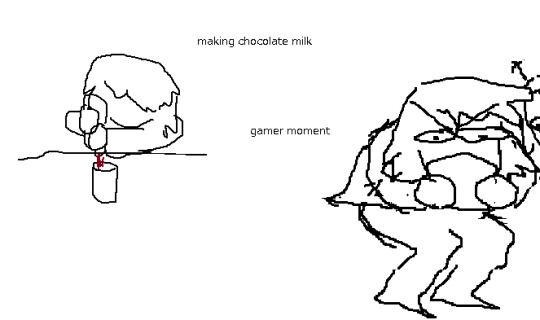
i did promise i'd say why i believe it's raining in the second segment. and it's because of the screenshot below. i believe that the rain will soon turn into storm - which causes a power outage that leads to the moment depicted. i can't... really tell you what's going on there and what cliffhanger we'll end up on this time. but maybe, just maybe, it'll involve a certain lost girl
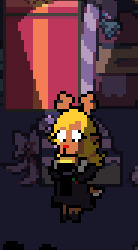
and that's about everything i could think of! if you don't follow me and for some reason still decided to read through... thank you?! i suppose?! we'll see how much of this will end up correct LMAO
...
and yes i think berdly is asking kris out to the festival
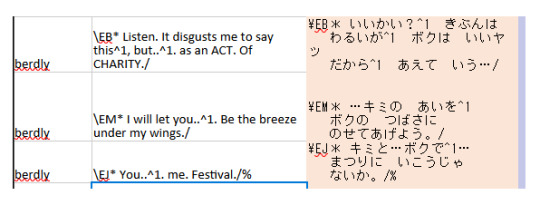
#galla.txt#utdr#deltarune#deltarune predictions#what the hell i'm maintagging this. why not#also this is more for my personal reference so i can either feel really smart for being right or like an utter buffoon#in the first case specifically so i can be like “SEEEEEE I CALLED IT”#anyway. deltarune not-quite-tomorrow but OH MY GOD IT'S STILL SO CLOSE
18 notes
·
View notes
Text
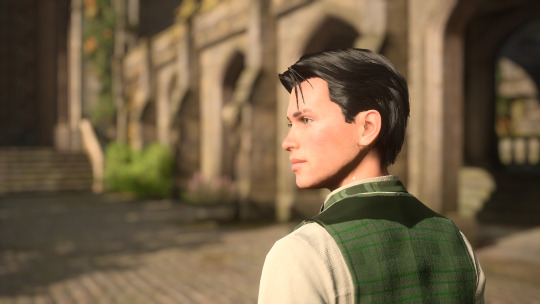
— Random Facts About Ale
[get to know this resident lover boy be why tf not]
⋆✴︎˚。⋆ ⋆✴︎˚。⋆ ⋆✴︎˚。⋆ ⋆✴︎˚。⋆ ⋆✴︎˚。⋆
(1) Adept Duellist
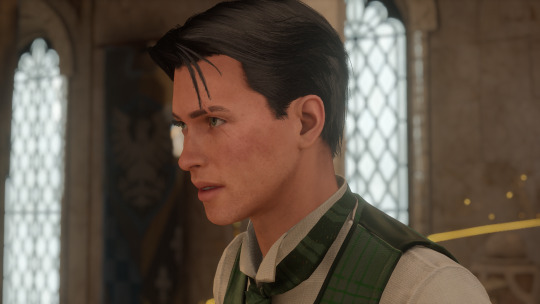
Alejandro possesses a genuine passion for dueling, viewing it not just as a competition but as an elegant dance of strategy, timing, and skill. His dedication has earned him a reputation as one of the finest duellists at Hogwarts, where the thrill of the match pulses through his veins.
Professor Hecat, with her rigorous training and insightful teachings, is his favorite mentor, inspiring him to refine his craft and embrace the nuances of each duel.
—
(2) Nature Enthusiast
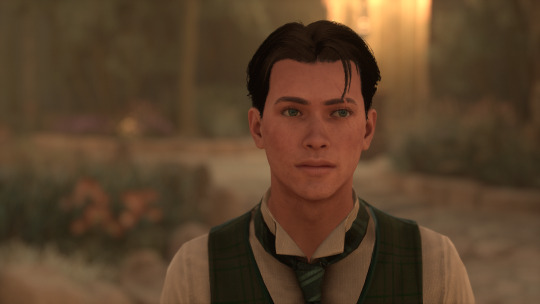
There’s a unique joy Alejandro finds in tending to plants, as it reflects a blend of patience, nurturing, and growth. His fascination began in childhood, where he would assist his mother in cultivating her garden of vegetables and herbs, learning from her both the joy and teachings that come from nature. This bond offered him an appreciation for the slow unfolding of life and the quiet lessons it holds.
In addition to his love for plants, Alejandro has an unwavering affection for animals of all kinds. His 'toxic trait' is his resolute determination to pet any creature he encounters, regardless of how friendly or fearsome it may be. This endearing quality often surprises others, as animals seem instinctively drawn to him, responding to his gentle demeanor and warm presence.
—
(3) Proud Muggle Heritage
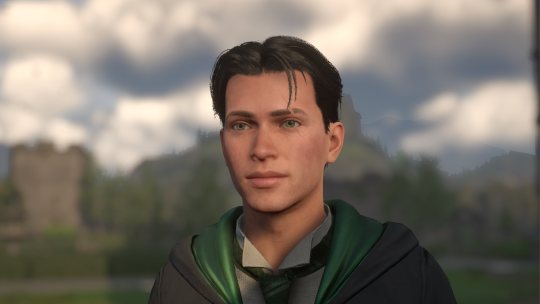
Yes, Alejandro proudly identifies as a Muggle-born.
Coming from a religious family that viewed witchcraft with skepticism, Ale's journey into the magical world was complex and fraught with challenges. When his family discovered his powers, instead of rejecting him, they chose to embrace and protect him. They kept his magical abilities confidential from the outside world to shield him from the scrutiny and potential ostracism associated with their religious beliefs.
Once sorted into Slytherin, Alejandro faced the harsh realities of fitting into a house with a reputation for elitism. Enduring taunts of being called a "Mudblood," he worked tirelessly to prove himself in this new environment. His background instilled in him a strong sense of justice; he became a vocal advocate for those who faced discrimination, particularly his fellow Muggles. This commitment often put him at odds with the more traditional values of his peers, showcasing his bravery and integrity.
—
(4) Aspiring Poet
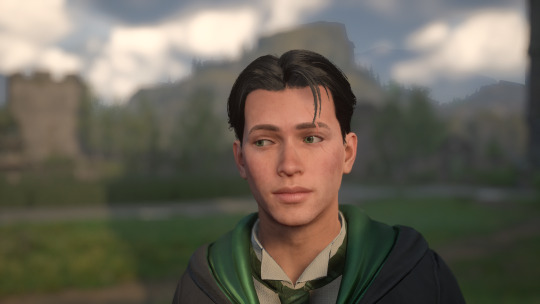
When he finds a moment of solitude, Ale often turns to his journal to express his thoughts and feelings through poetry. This creative outlet serves as a refuge, allowing him to unwind and examine the intricate tapestry of emotions swirling within him. Each poem becomes a reflection of his experiences, from the beauty of nature to the complexities of his relationships. This artistic side not only enriches his character but also offers glimpses into his inner life—revealing the layers beneath his charming exterior.
—
(5) Unreturned Affection
(shot by: @acslytherpuff ❤️🔥)
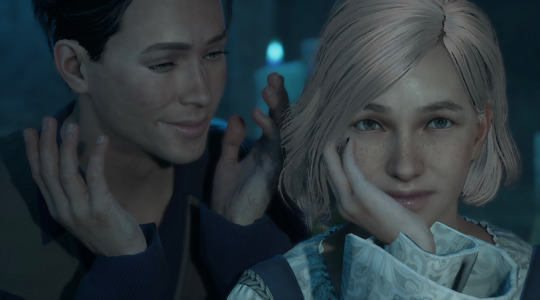
Alejandro's heart has long belonged to Val, a deep and unrequited love that shapes much of his emotional landscape.
His infatuation ignited during their fifth-year DADA class when Val triumphantly defeated Sebastian in a duel, a moment that left an indelible mark on him. From that point on, Alejandro yearned to be closer to her, and remarkably, they developed a close friendship that he cherished deeply.
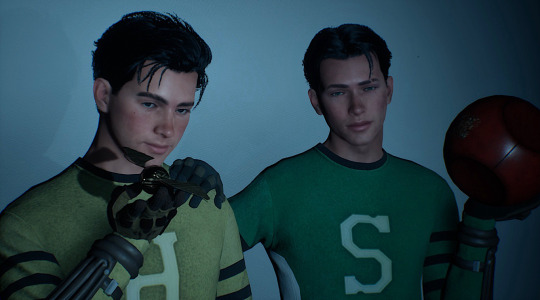
(shot by and mc, alvin, on the left belongs to: @acslytherpuff )
In his quest to spend more time with Val, Alejandro enrolled in flying classes despite his lack of enthusiasm for the subject. His willingness to step out of his comfort zone speaks volumes about his dedication to her—he even joined the Quidditch team, knowing it was close to her heart. Through both joyous times and challenging moments, Alejandro has stood by Val’s side as a steadfast friend, offering support and encouragement, even as his heart ached with unspoken feelings.
Despite the clarity of his emotions, he has refrained from explicitly confessing his love for Val; instead, his actions often speak louder than words. Whenever she’s near, Alejandro is transformed from a suave, flirtatious charmer into a clumsy, endearing mess, making it clear how smitten he is.
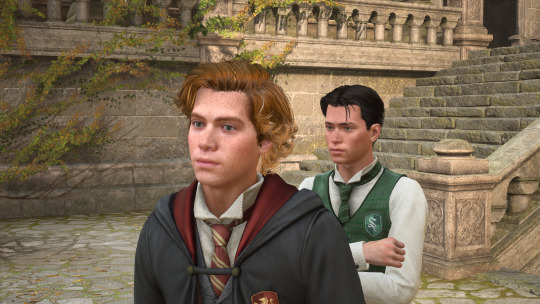
His chance at romance nearly materialized during their sixth year, but Garreth's unexpected arrival complicated matters and ignited jealousy in Alejandro, whom he secretly despises. Nevertheless, Alejandro’s selflessness shines through—his newfound angst is tempered by the knowledge that if Val is happy and safe, that’s all that truly matters to him, even if he isn’t the one who makes her feel that way.
⋆✴︎˚。⋆ ⋆✴︎˚。⋆ ⋆✴︎˚。⋆ ⋆✴︎˚。⋆ ⋆✴︎˚。⋆
#things about ale#alejandro salvatori#hogwarts legacy#hogwarts legacy oc#slytherin#hogwarts legacy screenshots#hogwarts legacy photo mode#hogwarts school of witchcraft and wizardry#hphl oc#hl oc
37 notes
·
View notes
Text
Attitude u.k.- Interview With the Vampire, literally: Meet the stars of the BBC’s most homoerotic show ever
Here, Reid and Anderson speak to Attitude about the challenges of making monsters human, and embracing the queerness of these creatures of the night.
What was your first encounter with the story of Interview with the Vampire?
Sam: There were two things I wanted to be as a child: an actor and a vampire. These interests culminated in my excitement to discover that they were shooting Queen of the Damned in Australia. That began my voyage through the works of Anne Rice: the novels, the movie…
Jacob: I remember seeing that film when I was a teenager and I thought it was fun. It wasn’t until I read the script that I got that excited, nervous feeling in my stomach that you get when you fall in love. I felt an immediate connection with Louis and now I’m as submerged in the world of Rice as Sam.
How does it feel taking on that mantle of such an iconic franchise?
Jacob: It’s a huge responsibility. You want to be respectful to the source material, but not so beholden to it that you’re not able to bring anything new to it. I felt responsible to both the fans and to Louis as a character. I wanted him to be loved by long-term fans despite being a different interpretation; I wanted him to be understood and relatable to newcomers.
Of course. There are some twists in this retelling. Louis is reimagined as Black, and there’s a definitive queerness introduced…
Jacob: I think that the books were always very queer, but that was lost in the movie. It was a film of the 90s – it featured two movie stars (Brad Pitt and Tom Cruise) who were known for reflecting very heteronormative hypermasculine standards and reaching a mainstream audience required interrupting the queerness of the novels. But when you revisit the original story, it’s clear that Louis is somebody hugely angry with a man he loved deeply and now presents them as a monster…
Why do you think vampires have this fan appeal specific to LGBT people?
Sam: It’s sexy otherness, isn’t it? Vampires are creatures of the night, but they’re also terribly misunderstood. Anne Rice is really responsible for our perception of the modern vampire. Before, it was Nosferatu, Dracula: mythic, horrific and predatory figures. Rice used psychology to give us insight into the mind of the monster. She makes you relate to them. Besides the point that vampires are just pretty cool, right?
What is the joy of playing a vampire?
In terms of being an actor and having the opportunity to dramatize a vampire, it’s incredibly fun because you get to be playful. You’re operating on a supernatural level, playing these crazy, wild characters. And then they are constantly reinvented, over and over again, becoming metaphors for different things at different times. It’s exciting.
And what’s the biggest challenge of taking on the vampire role?
Jacob: My biggest challenge is quite specific to Louis. He is human to a fault and his humanity constantly rubs up against his vampiric nature. He’s so connected to his past where the vampire is a character of the present, of the moment, always on the hunt. Louis is incapable of ever being in the present moment. He’s a monster trapped in his humanity.
And Lestat is a very different beast…
Sam: I love Lestat. He’s the biggest hot mess in the world, but equally, he’s embraced his intense power. He never wanted to be a vampire. But in the face of adversity, he’ll be damned if he’s going to wallow about it. He embraces it instead and makes the most of the situation. He’s very admirable in that rather than suffering through life, he’s going to laugh through it, even though he might be laughing maniacally and with a sense of sadism.
Who are your favourite pop culture vampires outside of the world of Anne Rice
Jacob: Mine’s The Count from Sesame Street. A fundamental part of everybody’s childhood!
Sam: I love Gary Alvin’s interpretation of Dracula, and that movie especially. I love the way they made that film because it’s so practically made and yet creates such an extraordinary world. Alvin himself, he’s like a warrior, wearing an insane meat suit and covered in prosthetics, with his long nails and his moving shadow. It’s joyful filmmaking.
15 notes
·
View notes
Text
Welcome to Belize With Alvin – See Belize Through Local Eyes

Hi, I’m Alvin J. Brown — a licensed Belizean tour guide, born in Placencia and now based in the lush Cayo District. After more than a decade supporting Belizean tourism from behind the scenes (building websites, running digital campaigns), I now guide travelers through the places I love most: the Barton Creek Cave, ancient Maya temples, jungle rivers, and village life.
This blog is where I share:
Photos and videos from recent tours 🛶🏛️
Stories about Belizean culture, food, and history 🌽🎶
Behind-the-scenes moments from life as a guide 📸
Travel tips and local insights for future visitors ✈️
If you're planning a trip or just curious about Belize, follow along. And if you’d like to support my work, check out my Ko-fi page — every bit helps fuel more storytelling from the heart of Belize.
👉 belizewithalvin.com 📸 Instagram: @belizewithalvin ☕ Ko-fi: ko-fi.com/belizewithalvin
Let’s explore together.
— Alvin 🇧🇿
2 notes
·
View notes
Text
[...]
By any reasonable measure, the jury of Manhattanites who yesterday found former president Donald Trump guilty on all 34 charges did its job, and did it well.
They took on a civic duty from which many others fled; during jury selection, when Judge Juan Merchan allowed potential jurors who did not want to serve essentially to walk out the door, over half the assembled pool headed straight for the exits. The jurors sat through six weeks of testimony, they were by all accounts attentive throughout the trial, and they asked precise, insightful questions of the judge during deliberations. Nobody’s truly in position to say if the jury got it right or wrong; they saw the evidence and we didn’t — most of us, that is, including those like me who followed every line of testimony as it happened; there’s no substitute for seeing it play out live. Reasonable minds could have come out either way, and this jury found that the prosecution carried its burden of proof beyond a reasonable doubt. The jury’s work, and their verdict, deserve respect.
But that doesn’t mean that every structural infirmity around the Manhattan district attorney’s case has evaporated. Both of these things can be true at once: The jury did its job, and this case was an ill-conceived, unjustified mess. Sure, victory is the great deodorant, but a guilty verdict doesn’t make it all pure and right. Plenty of prosecutors have won plenty of convictions in cases that shouldn’t have been brought in the first place. “But they won” is no defense to a strained, convoluted reach unless the goal is to “win,” now, by any means necessary and worry about the credibility of the case and the fallout later.
The following are all undeniable facts.
The judge donated money — a tiny amount, $35, but in plain violation of a rule prohibiting New York judges from making political donations of any kind — to a pro-Biden, anti-Trump political operation, including funds that the judge earmarked for “resisting the Republican Party and Donald Trump’s radical right-wing legacy.” Would folks have been just fine with the judge staying on the case if he had donated a couple bucks to “Re-elect Donald Trump, MAGA forever!”? Absolutely not.
District Attorney Alvin Bragg ran for office in an overwhelmingly Democratic county by touting his Trump-hunting prowess. He bizarrely (and falsely) boasted on the campaign trail, “It is a fact that I have sued Trump over 100 times.” (Disclosure: Both Bragg and Trump’s lead counsel, Todd Blanche, are friends and former colleagues of mine at the Southern District of New York.)
Most importantly, the DA’s charges against Trump push the outer boundaries of the law and due process. That’s not on the jury. That’s on the prosecutors who chose to bring the case and the judge who let it play out as it did.
The district attorney’s press office and its flaks often proclaim that falsification of business records charges are “commonplace” and, indeed, the office’s “bread and butter.” That’s true only if you draw definitional lines so broad as to render them meaningless. Of course the DA charges falsification quite frequently; virtually any fraud case involves some sort of fake documentation.
But when you impose meaningful search parameters, the truth emerges: The charges against Trump are obscure, and nearly entirely unprecedented. In fact, no state prosecutor — in New York, or Wyoming, or anywhere — has ever charged federal election laws as a direct or predicate state crime, against anyone, for anything. None. Ever. Even putting aside the specifics of election law, the Manhattan DA itself almost never brings any case in which falsification of business records is the only charge.
Standing alone, falsification charges would have been mere misdemeanors under New York law, which posed two problems for the DA. First, nobody cares about a misdemeanor, and it would be laughable to bring the first-ever charge against a former president for a trifling offense that falls within the same technical criminal classification as shoplifting a Snapple and a bag of Cheetos from a bodega. Second, the statute of limitations on a misdemeanor — two years — likely has long expired on Trump’s conduct, which dates to 2016 and 2017.
So, to inflate the charges up to the lowest-level felony (Class E, on a scale of Class A through E) — and to electroshock them back to life within the longer felony statute of limitations — the DA alleged that the falsification of business records was committed “with intent to commit another crime.” Here, according to prosecutors, the “another crime” is a New York State election-law violation, which in turn incorporates three separate “unlawful means”: federal campaign crimes, tax crimes, and falsification of still more documents. Inexcusably, the DA refused to specify what those unlawful means actually were — and the judge declined to force them to pony up — until right before closing arguments. So much for the constitutional obligation to provide notice to the defendant of the accusations against him in advance of trial. (This, folks, is what indictments are for.)
In these key respects, the charges against Trump aren’t just unusual. They’re bespoke, seemingly crafted individually for the former president and nobody else.
The Manhattan DA’s employees reportedly have called this the “Zombie Case” because of various legal infirmities, including its bizarre charging mechanism. But it’s better characterized as the Frankenstein Case, cobbled together with ill-fitting parts into an ugly, awkward, but more-or-less functioning contraption that just might ultimately turn on its creator.
Trump will appeal, as is his right, and he’s certain to contest the inventive charges constructed by the DA. I won’t go so far as to say an appeals court is likely to overturn a conviction — New York law is broad and hazy enough to (potentially) allow such machinations — but he’s going to have a decent shot at a reversal.
“No man is above the law.” It’s become cliché, but it’s an important point, and it’s worth pausing to reflect on the importance of this core principle. But it’s also meaningless pablum if we unquestioningly tolerate (or worse, celebrate) deviations from ordinary process and principle to get there. The jury’s word is indeed sacrosanct, as I learned long ago. But it can’t fix everything that preceded it. Here, prosecutors got their man, for now at least — but they also contorted the law in an unprecedented manner in their quest to snare their prey.
This article originally appeared in the free CAFE Brief newsletter. You can find more analysis of law and politics from Elie Honig, Preet Bharara, Joyce Vance, and other CAFE contributors at CAFE.com
6 notes
·
View notes
Text
By Douglas Schwartz
Without safe cities, including New York, the nation’s largest, America’s prospects are dim. Cities house over 80% of Americans, a figure that has risen steadily over time. The collective experiences of the 12 New York jurors selected to judge subway hero Daniel Penny provide insight regarding the city’s status. Penny is charged with manslaughter and criminally negligent homicide by one of your favorite president’s favorite prosecutors, New York City DA Alvin Bragg.
Juror #1 “has seen outbursts on the subway before” and “feels apprehensive about being physically threatened.”
Juror #4 ”has witnessed subway outbursts and has felt personally targeted.”
Juror #5 “has witnessed outbursts and has felt personally targeted.”
Juror #6’s “daughter was once assaulted in Times Square.”
Juror #7 “has seen outbursts.”
Juror #9’s husband “survived a street mugging . . . and said ‘Yes, of course’ she has witnessed subway outbursts.”
Juror #10 is a “woman who endured harassment on a near-empty subway car.”
Juror #11 “survived a robbery four years ago . . . he said he has witnessed outbursts.”
Juror #12 “has seen outbursts.”
Two jurors are attorneys, one female, one male. Given the facts of the case and jurors' experiences, the likelihood of Penny’s conviction seems remote. The Penny trial echoes 1987’s Bernhard Goetz trial. Goetz was acquitted by a jury after having shot four black youths who allegedly attempted to rob him on a subway. 1980s subway robberies have largely been replaced by today’s mental health cases creating their own chaos. In Goetz’s era, 38 subway crimes a day were reported and the city’s annual murder rate hovered around 2,000. Those numbers are now down to 6 and 386, respectively. Rudy Giuliani won his first mayoral election six years after Goetz’s trial, beginning the city’s crime turnaround. The strength of the case against Goetz was orders of magnitude greater than the evidence against Penny, yet a New York jury refused to convict Goetz, victim of a previous mugging and beating, of attempted murder and first-degree assault. Ironically, with the recent assassination of Peanut the squirrel, Goetz went on to become a squirrel rescuer. One of his four shooting victims eventually committed suicide after serving 25 years for rape; another was in and out of prison.
2 notes
·
View notes
Note
Hi! I have done as the instructions of the Egypt sand free tarot reading. Can you answer one question of mine? Thank you <3
If Alvin would be together with me, will he be a good partner for a long term commitment? (If you can please be detailed with the answer) <3.
Free Psychic Reading By Egyptian Sand! (PAID READINGS ARE ALSO OPENED!) 🏺🌟✨
Hello! Let’s dive into the sand to see what messages come forward about your connection with Alvin 🏜️✨
The first pattern emerging is two intertwined rings 💍, a symbol of unity, partnership, and commitment. This suggests that there is potential for a long-term relationship with Alvin. The rings intertwining shows that you both can complement each other’s strengths and support one another in a balanced way. It feels like there is a genuine bond and mutual respect between you two, which can grow into something lasting.
Next, I see a mountain 🏔️. While this can represent challenges, it also symbolizes strength, stability, and endurance. A relationship with Alvin might not always be smooth, but this symbol shows that he has the ability to weather difficulties and stick with you through hard times. The mountain suggests that if you face any obstacles together, they will make your connection stronger, not weaker. 💪🌟
Lastly, a heart ❤️ appears, but it’s not just any heart—it’s surrounded by waves 🌊. This tells me that Alvin might be someone who is emotionally deep but also requires patience to fully open up. The waves represent emotions flowing in and out, so there might be times where he needs space or time to process. However, once he’s emotionally committed, the heart shows he is caring and loving, providing the affection and attention needed in a long-term relationship. 💓
Summary: Alvin has the potential to be a good long-term partner, showing a mix of stability, loyalty, and emotional depth. While you may face some challenges together, they will strengthen your bond. His heart is in the right place, and he has what it takes to build a meaningful, lasting relationship with you. 🌹💍🏔️❤️
Got questions or need some insight into your life? I'm here to help with personal psychic readings! For just $7, you can get answers to up to 7 questions! More info at:
In case anyone else here on tumblr would like a free psychic reading, Click the link and follow the instructions (I answer only to those who follow the instructions, thank you):
#Aries#Taurus#Gemini#Cancer#Leo#Virgo#Libra#Scorpio#Sagittarius#Capricorn#Aquarius#Pisces#horoscope#astrology#zodiac#astro#astro observations#astro community#astroblr#astro placements#astro notes#astrology notes#zodiac signs#astrology tumblr#astrologer#astrology signs#natal chart
4 notes
·
View notes
Text
The Intan is a one-of-a-kind boutique museum with over 5,000 Peranakan artifacts, a unique culture that came to be in the 15th century in Southeast Asia. In a relatively young Singapore, which became an independent sovereign country in 1965, this is quite a rare treat. The Intan is also nestled in the charming precinct of Joo Chiat which has been designated as Singapore's first Heritage Town by the government.
The Intan's curator and owner, Alvin Yapp, lives in the museum. All the artifacts and antiques, including the exquisite material culture of the Peranakans like the beaded shoes and tiffin carriers, are part of Yapp's personal collection.
Unlike regular museums where visitors appreciate exhibits through audio guides or write-ups, and perhaps the occasional docents, all visitors to the Intan get personal tour from Yapp. An affable and interesting personality, he offers his guests quite a good dose of the Peranakan culture through his encounters and stories, often peppered with good humor and great insights. Every visit to the Intan comes with delightful Peranakan cakes and specially brewed tea. If you're lucky, and time allows, Yapp might play a song or two on the piano.
Visitors who want a more customized experience can arrange for hands-on learning of beading, coloring of tiles, appreciation of the beautiful Peranakan jewelry, or even a wellness program involving a sound bath.
It is a highly immersive experience where you can learn about a unique culture and experience the charming hospitality of a local in his house.
13 notes
·
View notes
Note
So, just read all of Twice Upon a Pointe this evening. And it is one of the greatest things ever. I have many many questions, but let's start with this one: why did you decide to set the "roman's" company in Miami instead of San Francisco?
I love this question! Also thank you, I'm so glad you like the fic!
It mostly has to do with George Balanchine, his style, and his repertory.
The very first spark of inspiration I had for this story back in 2019 was Tarantella. I found this video of Edward Villela doing Tarantella in 2019, and said "That's Percy Jackson. If he was a ballet dancer, that would be his ballet." And the story really started to spin out from there, with the next major piece of inspiration being The Sleeping Beauty, which is my favorite ballet (besides Alvin Ailey's Revelations).
So it was immediately clear to me that Percy was a Balanchine dancer, with this very quick, very American style. And so when I was thinking of a ballet company that might tempt him, I new it needed to be one with a strong Balanchine rep. While SFB does do Balanchine ballets, Miami is the other major US company that does his rep, and it was actually founded by Edward Villela, who worked closely with Balanchine and had several ballets choreographed for him, including Tarantella, Rubies, Prodigal Son, and Apollo. (I decided not to bring in real dancers as much as possible, name dropping only Edward Villela and Patrica McBride in passing for authenticity sake. I didn't want the story to get too tied up with real dancers, particularly dancers with more recent careers like Daci Kistler and Wendy Whelan, who would 100% have been huge inspirations for Annabeth). So Miami CB seemed like the perfect fit. IRL, it's also a company that takes a lot of SAB dancers, which added authenticity to Percy and Rachel getting initial offers there.
I also like playing with weather motifs and the pathetic fallacy just a little. Making it Miami meant I got to contrast the cold of January and February in New York with the warmth and humidity of Miami in March. On a symbolic level, it raises the question: is it hot because of passion, hard work, and sweat? Or is there a tension under the surface? Or is it simply just hot? (Also my only other complete multi-chapter fic is a Star Wars fic called More Light Than Heat, so this is a repeat symbolic fixation of mine).
The other less story-relevant reason was that the major source of information for NYCB has been the ballerina Kathryn Morgan and her YouTube channel (I mean, she literally has a series on her channel called Once Upon a Pointe). When I was coming up with the story in 2019 and first writing it in 2020, she was a soloist with Miami CB. So, as I was drafting the story the first time around, I made it Miami because I thought I'd get some insights into their company from her channel, and thus could write with a certain insider knowledge and authenticity like I could with NYCB. Unfortunately, she left Miami CB after being mistreated. Thankfully, she's gone on to do many wonderful things since then (she recently danced Giselle, it's beautiful, it's on youtube go watch it), but that means I never got the insights into the company.
But it is still a top five company with a strong Balanchine base, and with connections to NYCB, so when I decided to rewrite the story, I just kept it as Miami.
#also annabeth's family is in sf#so i feel like if percy went to sfb and wanted to stay#when she couldn't go because she wasn't getting an offer and new york was her life#him going where her family is without her would have added an additional layer of trauma to annabeth's story that i simply#could not put her through#twice upon a pointe
2 notes
·
View notes
Text
Nanatsuma Fridays!
So we got the Carlos and Ophelia backstory that was cutout last episode. Brief, but gave some really sad insight into how the Salvadori family views sex and their bodies as just a tool to her access to stronger bloodlines. Carlos taught her that doesn’t have to be her only purpose.



Lol, Guy is mean for teasing Katie about Oliver getting horny in the labyrinth. He’s right though. Even the sight of Nanao sweat getting Oliver all hot and bothered. He so real 😂



Still don’t get how Cyrus isn’t a 45 year old man. No way bro is a Kimberly student lol. All the playing with the dead has really aged him.

Really goes to show you how strong a guy Alvin is to use Dolor on himself every time he saw Ophelia. Someone with that level of commitment and determination to his friends is the perfect fit for a leadership position at this academy. But more importantly, he and his friends totally changed Ophelia’s outlook on life which can’t be understated

Fuck the kids who bullied her because she was close to Alvin. I just hate Ophelia didn’t talk to her friends before totally changing her personality all because of those idiots. The only people who matter are those who actually know you.

A solid episode, but I wish they’d have spent more time on this volume. This is supposed to be a very powerful emotional climax but the pacing.. they removed a lot of stuff between Carlos and Ophelia, stuff with Alvin, etc. For example how Ophelia has been getting pregnant by make students at school since day 1. I wish they’d have given this the time they gave volume 1.
Please be a good finale next week 🙏🏾

#anime fall 2023#2023 anime fall#fall 2023 anime#fall 2023 anime to watch#fall 2023 new anime#anime tumblr#nanatsuma#nanatsu no maken ga shihai suru#seven spellblades#the reign of the seven spellblades#reign of the seven spellblades
7 notes
·
View notes
Text
Remembering Our Veterans: Stories of Heroism and Sacrifice
Remembering Our Veterans: Stories of Heroism and Sacrifice http://chuckschmalzried.net/remembering-our-veterans-stories-of-heroism-and-sacrifice/?utm_source=rss&utm_medium=rss&utm_campaign=remembering-our-veterans-stories-of-heroism-and-sacrifice Veterans Day is a time to honor and remember the countless men and women who have served their countries in the armed forces. It is an opportunity to pay tribute to their courage, dedication, and sacrifices. Each veteran has a unique story, and their experiences often exemplify the heroism and selflessness that characterize their service. This article highlights a few of these stories to commemorate the brave veterans who have made a difference. Audie Murphy: Audie Murphy, one of World War II’s most decorated American combat soldiers, received 33 awards and decorations, including the Medal of Honor. Murphy’s heroism is best exemplified during a battle in France when he held off a German company of soldiers, called in artillery fire on his position, and then led a successful counterattack. Desmond Doss: Desmond Doss, a Seventh-day Adventist and conscientious objector, served as a combat medic in World War II without carrying a weapon. Despite facing intense combat and refusing to bear arms, Doss saved 75 men during the Battle of Okinawa, earning him the Medal of Honor. Alvin York: Sergeant Alvin York was a highly decorated U.S. soldier during World War I. In the face of heavy enemy fire, he captured 132 German soldiers and silenced 35 machine guns, a feat for which he was awarded the Medal of Honor. York’s story is an example of remarkable courage and resourcefulness. Harriet Ida Pickens and Frances Wills: During World War II, Harriet Ida Pickens and Frances Wills made history as the first African American WAVES (Women Accepted for Volunteer Emergency Service) officers. They broke racial and gender barriers by enlisting in the U.S. Navy, paving the way for future generations of women of color to serve in the armed forces. General Norman Schwarzkopf: General H. Norman Schwarzkopf, known as “Stormin’ Norman,” commanded coalition forces during Operation Desert Storm in the early 1990s. His leadership and strategic insight played a pivotal role in Kuwait’s swift and successful liberation from Iraqi forces. Mary Edwards Walker: Dr. Mary Edwards Walker, a contract surgeon for the Union Army during the Civil War, became the first and only woman to receive the Medal of Honor. She served in numerous battles, including Bull Run, Fredericksburg, and Chickamauga, where she was captured and held as a prisoner of war. Robert Maxwell: Technical Sergeant Robert D. Maxwell, a World War II veteran, demonstrated incredible heroism during the D-Day invasion of Normandy. He led his unit through fierce enemy fire to achieve their mission and saved many lives. Maxwell was awarded the Medal of Honor for his extraordinary bravery. John Basilone: Sergeant John Basilone was a Marine Corps veteran who received the Medal of Honor for his heroic actions during the Battle of Guadalcanal. His leadership and bravery in intense combat were instrumental in repelling enemy forces. It’s essential to remember and honor the brave men and women who have served in the military, protecting the values and freedoms that we hold dear. These stories remind us of the remarkable individuals who have answered the call to serve their nations. They inspire us to express gratitude and appreciation for their selflessness and sacrifices. The post Remembering Our Veterans: Stories of Heroism and Sacrifice first appeared on Chuck Schmalzried | Stories of Heroes. via Chuck Schmalzried | Stories of Heroes http://chuckschmalzried.net November 07, 2023 at 12:15PM
3 notes
·
View notes
Text
More obscure muses ( Introduction ) series.
Fandom: Tales of Xillia.
Muse- Jude Mathis

Age 15-16 ( games )
Jude Mathis is one of the two main characters in Tales of Xillia. He is a medical student training in the royal city when he is engulfed into Milla Maxwell's adventures.
Jude is described by his mother, Ellen, as "too quick to help others." He is always concerned about the well-being of those around him, even at the cost of his own. When Milla explains to Ellen the story of how they met, she says that it sounds exactly like something he would do, since he's been like this ever since he was a young child, and he was teased and even bullied for it. Yet, even when he came home all beaten up, he would still be smiling underneath.
It is later revealed by Leia that the reason why he is so helpful is because of a desire to feel wanted, due to being home alone more often than not when he was a kid. Jude is also shown to be very curious, often getting concerned with things that have nothing to do with the situation at hand, such as when he noticed a strange girl with a doll running around near Hamil and a group of shady men chasing her and couldn't stop thinking about it. However, this way of thinking, along with his impulsive inclination to help others, earns him criticism from Alvin, who claims he has "a nasty habit of poking [his] nose where it doesn't belong," since his curiosity and decision to help Milla is exactly what made all three of them wanted criminals. Milla, on the other hand, admires him for this trait, affectionately calling him a do-gooder on several occasions.
Despite this impulsive nature, Jude is usually calm and composed, which only increases as he spends more time with Milla and the others. According to Leia, he's always been like this, and Alvin suspects that he's been "freakishly level-headed since he was born". Although he comes off as stupid and reckless at times, he is simply naive when it comes to the ways of the world. In reality, Jude is very intelligent, as not only is he an honor student in Fennmont, but he's able to come up with highly effective strategies very quickly. His tactical brilliance is enough to impress both Alvin and Milla, with the latter noting that few people can think as fast as he can. He is a very diligent student in Fennmont, and was offered an opportunity to become an apprentice medical doctor after graduation by Professor Haus.
Jude is also shown to be a pacifist, as he frequently makes remarks after or outside of battle that suggest he is against fighting, which makes sense given that he's been trained as a doctor. He also starts off frightened every time he gets into a fight, something he admits to Milla and Alvin, but puts aside that fear since he knows that it's either him or his enemies. By the time the group reaches Kanabalar, however, Jude's gotten so used to fighting that it feels almost like second nature, and Alvin even claims that he'd do well as a mercenary, to the objections of everyone else in the party.
Jude is also shown to be a good judge of character, as he is easily able to pick up on the hints to Alvin's shady nature and guessed correctly that he isn't the kind of person to help people without expecting anything in return, like he and Milla are.
Jude is also a very dedicated person; despite his young age, he follows Milla in the hopes that he may be of some use to her. He seems to have gotten braver since he met her, as he gained the courage to stand up to his father Derrick, something he was never able to do when he was younger. He is also a great friend to all his companions, being both insightful and forgiving, especially to Alvin.
2 notes
·
View notes
Text
Let's not forget that DoB is where:
— We learn of the Astrid's backstory in which her father was temporarily paralysed by a Flightmare which damaged their reputation and may have contributed to how Astrid was in the series.
— We first get proper insight into why Snotlout is the way he is (i.e. Spitelout), and that Snotlout too can genuinely give a damn about his dragon.
— That the twins can actually be super clever/smart in their own way (often times accidentally), too. (Like when they tricked Snotlout into doing as they wanted by tempting him with a place in their emergency bunker if he can get everything on their BS list, or when they accidentally discovered that fireworms glow brighter the closer they are together.)
— That Fishlegs is afraid of the dark.
— That Gronckles can make "Gronckle Iron" a light but incredibly sturdy metal.
— That Alvin is a tricky son of a gun. (Also the way they set up several things earlier on to pay them off later...)
— That Dagur is obsessed with Hiccup, but also Berk has relations with another island which has not ceased their dragon killing ways (so far).
— That whispering deaths look after their own, including Screaming Deaths (possibly only when litter-mates though, idk.)
— Snotlout is a capitalistic son of a gun.
— The Fireworm Queen is a Q U E E N. I mean, she attack, she defend, but most importantly she a stoker class friend... the way she healed Hookfang despite it looking like she was killing him.
— Stormfly and Toothless look so cool when illuminated by bioluminescent algae water. (Honestly, maybe that's how the Light Fury should have been more like...)
Edit: I mixed up Riders of Berk with Defenders of Berk because life on the high seas sometimes leads to confusion.
It always irks me that some people have seen RttE but not RoB/DoB. Like yes I get it RttE is obviously superior but. Riders/Defenders of Berk is fucking great too. And has crucial character moments that RttE just. Lacks. When in RttE will you get to see Toothless befriending a cute lamb or getting jealous over a younger (adopted) sibling? Mildew is a fucking nuts character to have as your starter villain because he's so realistic and so threatening. Hiccup and Stoick are still healing their relationship after Movie 1 in RoB/DoB so we get to see conflict between them and more of Stoick's character development (I think his development was stronger in RoB/DoB than in RttE tbh). Also Dagur was the villain in Defenders of Berk so you know how good that was. Also we get context for shit like Heather and Gronckle Iron and where the Screaming Death came from. Genuinely Defenders of Berk especially is so fucking good.
354 notes
·
View notes
Text
Alvin Ubaldo Shares How to Create a Retirement Income Ladder

Retirement planning is one of the most important financial goals many people strive to achieve, but it can also be one of the most challenging. One of the key concerns for retirees is ensuring a steady and reliable income stream that will last throughout their golden years. Alvin Ubaldo, a trusted name in personal finance and investment strategies, shares his expert insights on how to create a retirement income ladder—a powerful approach to generating consistent income in retirement while minimizing risks.
What Is a Retirement Income Ladder?
A retirement income ladder is a strategy that involves structuring your investments and assets in a way that ensures you receive a predictable income at regular intervals. It’s similar to how a ladder has rungs at different heights; your income sources are “laddered” so that as one investment matures or begins paying out, another is ready to take its place. This helps prevent the risk of running out of money too soon and reduces dependency on any single investment or market condition.
Alvin Ubaldo emphasizes that the income ladder approach is about balancing liquidity, growth, and safety. By staggering your investments and income sources, you can optimize cash flow and safeguard your nest egg.
Why Create a Retirement Income Ladder?
The main benefit of an income ladder is that it provides retirees with a reliable flow of money while reducing exposure to market volatility. Here’s why Alvin Ubaldo recommends this method:
Predictability: Knowing when and how much money you will receive helps with budgeting and managing expenses.
Reduced Market Risk: Because income comes from staggered investments, you’re not forced to sell assets during market downturns.
Flexibility: You can modify the ladder to fit your unique risk tolerance and income requirements.
Tax Efficiency: Strategic planning allows you to take advantage of tax-advantaged accounts and reduce your overall tax burden.
How to Build Your Retirement Income Ladder
Alvin Ubaldo deconstructs the procedure into distinct steps:
1. Assess Your Income Needs
Before you build the ladder, determine how much income you will need each year to cover your living expenses, healthcare, and lifestyle choices. Factor in inflation and unexpected costs to ensure your plan is realistic.
2. Identify Your Income Sources
Look at all potential income streams available to you, including Social Security, pensions, annuities, rental income, dividends, and withdrawals from retirement accounts (like IRAs and 401(k)s).
3. Segment Your Investments by Time Horizon
The idea is to divide your investments into “buckets” based on when you will need to access the money:
Short-term bucket (0–5 years): Keep this money in low-risk, liquid assets such as savings accounts, money market funds, or short-term bonds. This is your immediate income source.
Mid-term bucket (5–10 years): Invest in medium-term bonds or dividend-paying stocks that provide a balance between growth and income.
Long-term bucket (10+ years): Allocate funds to growth-oriented investments like equities to outpace inflation and grow your portfolio.
4. Ladder Your Fixed-Income Investments
Alvin Ubaldo advises building a ladder with bonds, CDs, or annuities that mature at staggered intervals. For example, you might purchase bonds maturing every year for the next 10 years. As each bond matures, you can use the proceeds for income or reinvest in a new bond at the far end of the ladder.
5. Coordinate Withdrawals Strategically
Withdraw from your buckets in a way that minimizes taxes and preserves your capital. Typically, you would use the short-term bucket first and allow long-term investments to continue growing.
6. Regularly Review and Adjust Your Ladder
Life circumstances and market conditions change, so it’s important to review your income ladder annually. Adjust investments or income goals to stay on track.
Alvin Ubaldo’s Final Thoughts
“Creating a retirement income ladder isn’t about following a one-size-fits-all plan,” Alvin Ubaldo says. “It’s about understanding your personal financial situation and designing a strategy that balances safety, growth, and predictability. With careful planning, you can enjoy your retirement years without financial stress.”
By following Alvin’s guidance, retirees can build a well-structured income ladder that offers peace of mind and financial security. Whether you’re just starting to plan for retirement or already retired, this strategy can help you manage your finances effectively and make the most of your hard-earned savings.
0 notes